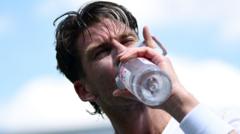Can Players Handle Wimbledon's Scorching Opening Day?

Wimbledon 2025: Battling the Heat on and Off the Courts
As the prestigious Wimbledon Championships kicked off on June 30, 2025, players, staff, and fans were met with record-breaking temperatures that transformed the iconic grass courts into a sweltering battleground. The All England Club, known for its tradition and excellence, found itself navigating the challenges posed by the hottest opening day in the tournament's history. This article delves into the measures taken to ensure player safety, the impact of high temperatures on performance, and the overall experience for spectators amid the intense heat.
Record-Breaking Temperatures: A Hot Start to Wimbledon
The opening day of Wimbledon 2025 saw air temperatures soar to 31.4°C by 14:00 BST, exceeding the previous record of 29.3°C set in 2001. This unprecedented heat prompted concerns across the board, as the UK Health Security Agency (UKHSA) issued an amber heat-health alert, warning of serious health risks associated with extreme temperatures, particularly for vulnerable populations.
Despite the scorching conditions, the tournament organizers had prepared extensively. Wimbledon employs the Wet Bulb Globe Temperature (WBGT) heat index, which takes into account several factors, including air temperature, humidity, and surface temperature. This comprehensive approach helps determine when to enforce the extreme heat rule, which allows for a 10-minute break during matches under specific conditions.
Player Safety: The Implementation of Heat Protocols
On the hottest days of competition, player safety remains paramount. While the extreme heat rule had not been enforced on the opening day, several strategies were put in place to help players manage the heat:
- Cooling Measures: Players received ice packs, cold towels, and ample water during changeovers to help regulate their body temperatures.
- Ball Boys and Girls Care: Young ball handlers were equipped with cooling scarves to help them cope with the heat while performing their duties.
- Health Monitoring: Medical staff were on standby to monitor players’ health, particularly for those showing signs of heat distress.
Britain's Sonay Kartal, after her opening match against Jelena Ostapenko, noted the challenges posed by the heat but also expressed appreciation for the cooling amenities provided. She admitted to a rookie mistake by not changing clothes after the first set but felt that the support helped her manage her performance effectively. "It was hot, but I had ice towels, cold drinks and stuff," Kartal stated. "It was nice to play in no wind, no rain."
Challenges for Players: Adapting to Extreme Conditions
The extreme temperatures did not deter players from giving their best on the court, but they certainly posed unique challenges. Two-time Wimbledon runner-up Ons Jabeur was forced to retire during her match after experiencing heat-related issues, highlighting the potential dangers of competing in such conditions. Meanwhile, American player Frances Tiafoe expressed a different perspective, stating, "Honestly, I didn't feel that hot out there." This variation in perceptions illustrates how individual tolerance to heat can differ significantly among athletes.
The Impact of Heat on Performance
High temperatures can significantly affect athletic performance. Players often struggle with:
- Dehydration: Increased sweating leads to fluid loss, which can impair physical and mental performance.
- Muscle Fatigue: Heat can cause quicker muscle fatigue, impacting endurance and strength.
- Reduced Focus: As temperatures rise, players may experience difficulties concentrating on the game, leading to uncharacteristic errors.
German player Eva Lys shared her experience, noting the challenges of playing in such heat: "It was tough. Really, really tough. I was sweating a lot, so my racquet was very slippery." As the tournament progresses, players will need to adapt their strategies and conditioning to cope with the ongoing heat.
Spectator Experience: Staying Cool Amid the Heat
For spectators hoping to enjoy the thrilling matches at Wimbledon, the heat posed its own set of challenges. The All England Club took steps to ensure fan safety and comfort:
- Hydration Stations: Over 100 water points were made available throughout the grounds, encouraging fans to stay hydrated.
- Shade and Rest Areas: Spectators were advised to take breaks from the sun, using hats, umbrellas, and towels to shield themselves from the heat.
- Health Guidelines: Fans were urged to wear light clothing, sunscreen, and to look out for each other during the sweltering conditions.
As the tournament continued, thousands of fans queued to enter the grounds, undeterred by the sweltering heat. However, the advice from health professionals remained clear: take time off the court and out of the sun.
Weather Forecast: Continued Heat Ahead
With high temperatures expected to persist throughout the tournament, the BBC Weather’s senior meteorologist, George Goodfellow, projected that conditions would likely remain dry, sunny, and very hot. Fans and players alike must prepare for continued heat, with forecasts suggesting temperatures could reach as high as 33°C.
As the tournament progresses, it is essential to monitor the health and well-being of players and spectators, ensuring that everyone can enjoy the matches safely. The All England Club's commitment to player and fan safety will be crucial in navigating the challenges posed by extreme weather conditions.
FAQs About Wimbledon 2025 and Extreme Heat
What is the extreme heat rule at Wimbledon?
The extreme heat rule allows players a 10-minute break during matches under specific conditions, typically after the second set for best-of-three matches or after the third set for best-of-five matches. This rule is determined using the Wet Bulb Globe Temperature (WBGT) heat index.
How does heat affect tennis players' performance?
Heat can cause dehydration, muscle fatigue, and reduced focus, all of which can significantly impact a player's performance. Players must adapt their strategies and conditioning to cope with high temperatures during matches.
What precautions are taken for spectators during hot weather at Wimbledon?
The All England Club provides hydration stations, encourages fans to seek shade, and promotes health guidelines, such as wearing light clothing and sunscreen, to ensure the safety and comfort of spectators during extreme heat.
As Wimbledon 2025 unfolds, the challenges of extreme heat will test the resilience of players and the adaptability of fans. With careful measures in place and an awareness of health and safety, the tournament aims to provide an enjoyable experience for all. As we watch the best players in the world compete on the iconic grass courts, how will they adapt their game to the sweltering conditions? #Wimbledon2025 #ExtremeHeat #TennisChallenges
Published: 2025-06-30 15:32:04 | Category: sport



